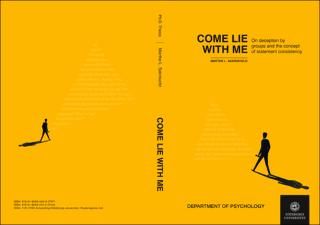| dc.description.abstract | Research on the topic of group deception has primarily focused on cooffenders. The aim of this thesis was to further our understanding of group deception by examining the context of honest and deceptive alibis corroborated by witnesses. Specifically, the deceptive pairs contained one partly innocent member, and this setup provides a different group dynamic as compared to cooffending groups with only guilty members. Furthermore, this thesis aimed to increase our knowledge of the consistency of such corroborated statements. Study I examined whether the consistency of corroborated honest and deceptive alibi-witness statements was moderated by the salience of event details. In line with the expectations and previous research, all pairs obtained lower betweenperson consistency scores for less salient details—however, truth-tellers’ consistency scores dropped considerably more than liars. Study II applied strategic interviewing through memory-enhancing tactics and examined whether this would increase the differences between honest and deceptive pairs on a within-subject measure. Contrary to the predictions, both honest and deceptive participants responded similarly to the memory-enhancing tactics. Study III approached the topic of counter-interrogation strategies in a new way and observed honest and deceptive pairs’ conversations while preparing for their interview in addition to collecting self-reported measures. The results partly supported the hypotheses. In line with the expectations, liars were concerned with establishing a story, keeping it simple and being consistent—and truth-tellers were concerned with being honest and detailed. However, contrary to the expectations truth-tellers were also concerned with establishing a story. Study IV manipulated between-person consistency in vignettes, and operationalised inconsistency both in terms of low degree of overlap as well as the presence of contradictions. The study examined whether these different operationalisations of statement consistency affected veracity judgements. Results showed that in line with the expectations and previous research, believability was rated lower, and guilt was rated higher for contradicting versus consistent statements. However, statements with a low degree of overlap were not rated less believable or more guilty than the consistent statements, which might imply that people are inattentive to overlap as a representation of inconsistency. In sum, this thesis illustrates that whether honest and deceptive pairs differ in between-person consistency seems to depend on the salience of the details, but also on how consistency is operationalised. Previous group deception literature on beliefs about statement consistency and counter-interrogation strategies is dominated by self-reports, and empirical studies testing between-person consistency primarily examine the degree of overlap. In order to move the field forward, we must empirically approach these topics with a wider range of designs (such as dialogue observations and vignettes) and be aware of—and systematically examine—different operationalisations.
Study I: Sakrisvold, M. L., Granhag P. A., & Mac Giolla, E. (2017). Partners under pressure: Examining the consistency of true and false alibi statements. Behavioral Sciences & the Law, 35(1), 75-90. http://doi.org/10.1002/bsl.2275
Study II: Sakrisvold, M. L., Luke, T. J., Mac Giolla, E., & Granhag, P. A. (2022). Can memory-enhancing interview tactics help distinguish honest and deceptive alibis corroborated by witnesses? Manuscript
Study III: Sakrisvold, M. L., Mac Giolla, E., Luke, T. J., & Granhag, P. A. (2022). What they say and what they do: A novel approach in the investigation of counter-interrogation strategies of honest and deceptive alibi-witness pairs. Manuscript
Study IV: Sakrisvold, M. L., Mac Giolla, E., Luke, T. J., & Granhag, P. A. (2022). Putting the consistency heuristic to the test: Are inconsistent statements judged more deceptive than consistent statements? Manuscript | en_US |
